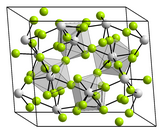
| |
| Identifiers | |
|---|---|
3D model (JSmol)
|
|
| ChemSpider | |
| ECHA InfoCard | 100.030.039 |
| EC Number |
|
PubChem CID
|
|
| RTECS number |
|
| UNII | |
CompTox Dashboard (EPA)
|
|
| |
| |
| Properties | |
| ThCl4 | |
| Molar mass | 373.849 g/mol |
| Appearance | white needles hygroscopic |
| Density | 4.59 g/cm3, solid |
| Melting point | 770 °C (1,420 °F; 1,040 K) |
| Boiling point | 921 °C (1,690 °F; 1,194 K) |
| Structure | |
| tetragonal | |
| Hazards | |
| Lethal dose or concentration (LD, LC): | |
LD50 (median dose)
|
332 mg/kg intraperitoneal mouse |
Except where otherwise noted, data are given for materials in their standard state (at 25 °C [77 °F], 100 kPa).
| |
Thorium(IV) chloride describes a family of inorganic compounds with the formula ThCl4(H2O)n. Both the anhydrous and tetrahydrate (n = 4) forms are known. They are hygroscopic, water-soluble white salts.
